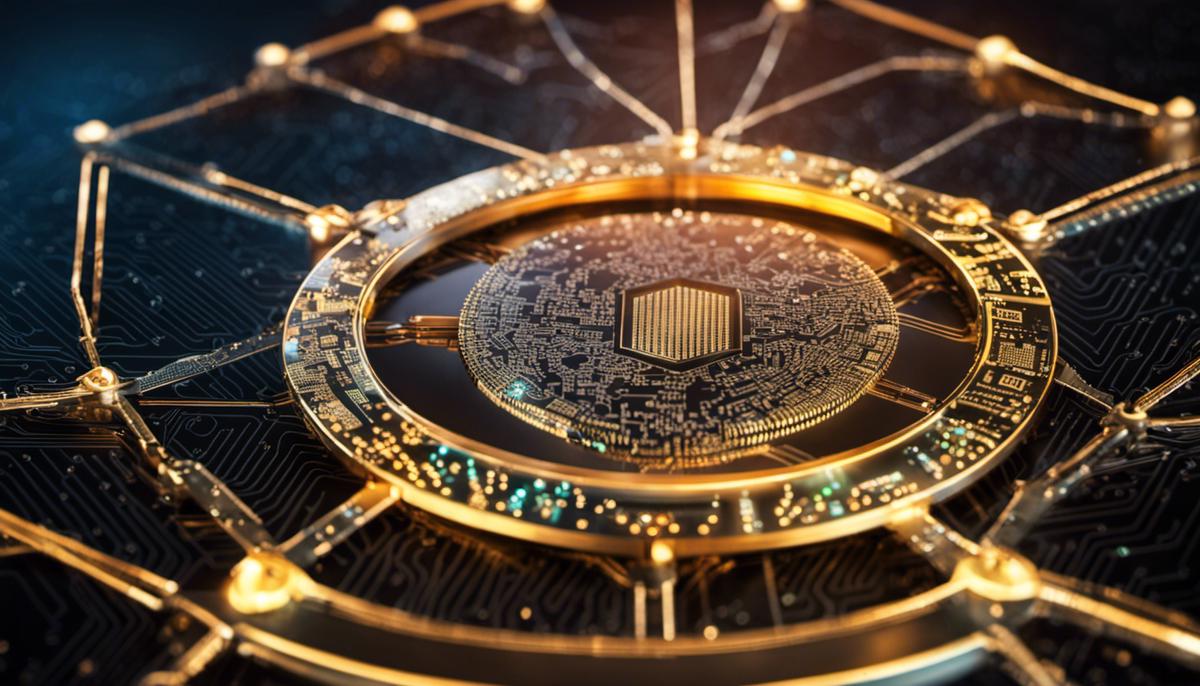In a world where technology has become an inseparable element of our daily lives, the importance of cybersecurity networking can’t be overstated. Our increasing dependence on electronic appliances and systems means that our valuable data and privacy are subject to potential threats. The science of cybersecurity networking enables us to understand, anticipate, and prevent these risks. This discipline, encompassing key methodologies and protocols, is instrumental in securing a network without restricting its functionality. Adding to its importance is the rapid advancement of technological innovations, each having a substantial impact on the nature of cybersecurity. Whether it’s the latest Artificial Intelligence-based protection mechanisms or challenges related to compliance and legislation, every facet adds a new dimension to the evolving landscape of cybersecurity networking.
Understanding the Basics of Cybersecurity Networking
Piecing Together Cybersecurity Networking: What You Need to Know
Since the dawn of the digital age, the importance of securing our global networks from prying eyes, sophisticated hackers, and malicious software has magnified exponentially. The various complicit components that form the backbone of cybersecurity networking can seem overwhelming. Unraveling these intricate concepts needs a clear understanding of its foundational elements. Let’s dive in.
At the core lies the interconnectivity of computers and servers, also known as networking. Gaining an understanding of networking basics like TCP/IP protocols, routers, switches, LANs, WANs, network topology, and the OSI model is essential. These form the foundation for data transmission across the internet, affecting how security is implemented and maintained.
Next, we face the enigmatic concept of encryption. A cornerstone of cybersecurity, encryption ensures the confidentiality and integrity of data by converting it into code. A firm grasp of various encryption algorithms, asymmetric and symmetric encryption, and their utilizations in SSL/TLS protocols is a requisite.
Identity and access management (IAM) is another crucial element. IAM systems define and manage the roles and access privileges of network users. Knowledge of multi-factor authentication, network access control (NAC), segregation of duties (SoD), and privilege access management (PAM) forms the base of controlling who has access to network resources.
The concept of firewalls and intrusion detection systems (IDS) is central to cybersecurity networking. Discerning the difference between a host-based firewall and a network-based firewall, understanding IDSs’ role in monitoring network traffic, and grasping how they protect against threats is key to mastering the art of cybersecurity.
Finally, a strong understanding of malware and other threats provides an essential lens for interpreting cybersecurity. Recognizing the characteristics of viruses, worms, Trojans, ransomware, and spyware, among other threats, aids in foreseeing potential vulnerabilities and creating robust security systems.
While a comprehensive understanding of the industry will take years, these foundational elements will pave the way for a sophisticated comprehension of cybersecurity networking. They provide a practical starting point that allows tech enthusiasts to guard against today’s most pressing cybersecurity challenges effectively. Cybersecurity isn’t just a concept—it’s a constant, evolving battle needing nimble strategies and a profound understanding of the terrain. After all, the best offense is a good defense.

Emerging Trends and Technologies
Ushering in a new Era in Cybersecurity Networking – The Cutting-Edge Advances and Developments
As the digital landscape evolves and technology becomes increasingly pervasive, so do the risks and threats that cybersecurity has to wrestle with. It’s a field that demands continuous transformation, increasingly sophisticated protectors, and an innovative mindset. Bypassing traditional standards, cybersecurity is shifting into a gear that makes attempts at hacking or system infiltration a daunting prospect for even the savviest threat actors.
Artificial Intelligence (AI) and Machine Learning (ML) have emerged as vanguards in the cybersecurity industry. AI-powered cybersecurity systems are breaking new ground, offering a proactive approach rather than a reactive one. These systems learn from each attack, building a comprehensive knowledge base that empowers them to anticipate and prevent future attacks before they occur.
Simultaneously, the rise of Secure Access Service Edge (SASE) is revolutionizing the way organizations regulate access to their IT resources. By merging WAN capabilities with network security services, SASE simplifies the tangled web of standalone services. By centralizing control over the network and applying policy-based security rules, SASE ensures that every access point is meticulously regulated and monitored – effectively nullifying unauthorized access and threats.
Quantum cryptography is another vanguard, heralding an era of virtually unbreakable encryption. Unhinging from the typical encryption labyrinth, quantum cryptography is based on the principles of quantum physics, which makes encryption keys impossible to predict or replicate. It’s a development that is shaking up the cybersecurity spectrum, rendering traditional encryption methods obsolete and ensuring the invulnerability of data transmission against cyber attacks.
Blockchain technology is also carving out a niche in cybersecurity networking. By decentralizing control and creating an open, transparent network of cryptography-secured data blocks, blockchain brings in the prospect of hack-proof systems. Its decentralized nature eliminates the vulnerability of single-point failures, and the open access enhances immunity against data tampering.
Alongside these, deploying Software-Defined Perimeter (SDP) can play a crucial role in protecting internal IT resources against external threats. By hiding IT resources behind a ‘black cloud’, SDP allows resources to be accessed only after the correct identity has been verified through a pre-authenticated connection.
All of these advances reflect the shifting landscape of cybersecurity networking. They underline a transition towards a more dynamic and anticipatory defense, largely powered by neural networks, AI, and quantum computing. These developments are revolutionizing the battlefield for cyber warriors, rendering unprepared systems significantly exposed and underlining the critical importance of staying ahead of the curve in cybersecurity advancements. As the world becomes more entwined with digital technologies, it will be exciting to see how these advances shape the future of cybersecurity networking.
Threat Landscape and Defenses
No longer is cybersecurity a mere concern over viruses and worms but a shifting frontier where dangers become increasingly sophisticated and predatory. One formidable threat in today’s cybersecurity landscape? It’s artificial intelligence (AI). More specifically, malevolent AI. Cybercriminals are weaponizing AI, supplementing traditional cyber-attacks with a pervasive intelligence that learns, adapts, and threatens to outsmart even our most potent defenses.
Machine Learning (ML), a subset of AI, adds an extra layer to the threat veneer. ML algorithms enable malware to evolve and adapt to a system’s attempts at defense, enhancing their evasion capabilities and prolonging system infection.
However, the flip side of this technology offers great promise. AI and ML aren’t just proponents of the problem but part of the solution. Defense mechanisms fortified with AI can analyze threat behavior, identify unusual patterns, and predict potential attacks with enhanced speed and accuracy. AI is also contributing to self-healing systems that can repair or restore themselves post-breach, effectively reducing downtime and damage.
Weaving into the cybersecurity narrative is another standout tech player: quantum cryptography. As quantum computing stirs the reality pot, its implications for cybersecurity are plentiful. In the hands of a hacker, quantum computers could crack traditional encryption algorithms in a blink. This looming inevitability propels quantum cryptography, a field harnessing quantum mechanics to secure information. While still largely in developmental stages, it is an area ripe with potential for future cyber defenses against quantum computing threats.
Another trend reshaping the cybersecurity landscape is Secure Access Service Edge (SASE). SASE combines network security and wide area networking (WAN) capabilities in a single cloud-based service. It allows businesses to apply security rules based on identity, real-time context, and risk assessment—bringing a more comprehensive and flexible defense strategy to the organization.
Often linked with cryptocurrencies, blockchain technology has found footing in cybersecurity. By decentralizing storage and applying a series of cryptographic hashes, blockchain provides an added layer of security. It makes data tampering and single-point failures nearly impossible due to its distributed ledger structure.
Where previous security measures emphasized securing the network perimeter, nowadays, that perimeter has blurred, principally owing to the shift to cloud infrastructures and remote working. Enter Software-Defined Perimeter (SDP). An SDP strategy controls access to resources based on identity, rendering elements of the infrastructure effectively invisible to those lacking the proper credentials.
The cybersecurity framework has also seen a pivot towards proactive defense. Threat hunting is a growing practice, challenging the traditional, reactive cybersecurity mentality. By actively searching for threats that may have evaded existing defenses, organizations can anticipate and mitigate breaches before they inflict significant damage.
Keeping ahead of cybersecurity advancements is no longer a benefit—it’s an absolute necessity. As technology evolves, the threats infesting the digital landscape will continue to multiply and mutate. A healthy obsession with staying ahead, combined with intelligent use of emerging technologies, will be critical in maintaining a robust defense strategy. As advanced tech such as AI and quantum cryptography continue to penetrate the cybersecurity realm, it’s safe to state the future of cybersecurity is already here. And it’s high time we faced it head-on.

Regulation and Compliance
Navigating Regulations in Cybersecurity Networking
For tech enthusiasts in the cybersecurity realm, understanding the regulatory landscape impacting the domain is crucial. It’s not just the advance of cryptography or machine learning that calls for attention but also the complexities of global, national, and industry-specific regulations. Webbed in these regulations are permissions and restrictions that demand adherence – or face imminent penalties.
Regulatory Considerations: A Maze to Traverse
Navigating cybersecurity regulations is a sophisticated task. Distinctly, GDPR (General Data Protection Regulation) and CCPA (California Consumer Privacy Act) revolve around data privacy. The emphasis is on how organizations collect, store, use, and transfer personal data. Understanding the nuances of these regulations and implementing ‘privacy by design’ would ensure compliance and protect against potential breaches.
International Trade Regulations, presenting another facet, impacts cybersecurity product development and distribution. For instance, the U.S. Commerce Department’s Bureau of Industry and Security (BIS) enforces the Export Administration Regulations (EAR) governing the export of dual-use items. Such regulations can influence how cybersecurity products are designed, marketed, and sold across borders, affecting trends in global cybersecurity networking.
In the industry-specific realm, healthcare and finance stand out with HIPAA (Health Insurance Portability and Accountability Act) and GLBA (Gramm-Leach-Bliley Act), respectively. HIPAA covers the privacy of health-related data, whereas GLBA focuses on financial institutions and the protection of consumer financial data. Compliance with these industry-specific regulations is non-negotiable.
Mandatory Regulatory Reporting
Another significant component is the regulatory requirement for breach notifications. Regulations like GDPR amplify the pressure to communicate security incidents promptly and transparently. With provisions related to mandatory notification of data breaches to authorities and affected individuals, companies are expected to take a proactive stance in breach detection and incident response.
Repercussions of Compliance Failure
Stepping out of the compliance purview can lead to hefty financial penalties. GDPR, for instance, can levy fines up to 4% of annual global turnover or €20 Million, whichever is higher. Notably, non-compliance can also lead to damaged brand reputation and potential civil litigation.
Outlook: Prioritizing Regulatory Adherence
While managing the onslaught of cybersecurity threats is, indeed, a result of deliberate choices where technical prowess is utilized, the importance of understanding and engaging with regulatory considerations cannot be whittled down. Regulatory compliance is not just about keeping penalties at bay but about fostering trust and confidence among consumers and partners. Cybersecurity networking, in its fully functional avatar, is a well-rounded synthesis of best practices, advanced tech mechanisms, and regulatory understanding.
With the continuous evolution of cybersecurity landscapes and the mountains of documentation associated with regulatory matters, comprehending these is a herculean tenure. A good understanding of applicable regulations can streamline company operations, reduce the risk of non-compliance, and ultimately bolster a company’s cybersecurity defenses. Being quick to improvise and commit to understanding these nuances is what differentiates the tech devotees from the rest. After all, isn’t that what every hardcore techie aspires for? The thrill of the problem, the drive for solutions, no matter how knotty the issue might seem – for the road less traveled by the tech novices is where the real fun begins!

Career Opportunities and Future Directions
Looking forward, the landscape of cybersecurity networking careers is dynamic, displaying promising signs of growth and development. The switch from manual, traditional methods to profound, technologically advanced approaches has opened doors for several exciting career opportunities in the cybersecurity networking domain.
First, it’s worth noting that the ‘Cyber Security Jobs Report predicted an increase of 3.5 million cybersecurity vacancies globally by 2021, indicating a vast number of new job roles being created in this field. This includes positions such as security analyst, security engineer, security architect, and chief information security officer (CISO), to name a few. As cyber threats continue to evolve in complexity and sophistication, so too will the demand for skilled cybersecurity professionals to counter these threats.
One emergent trend shaping the cybersecurity occupational sphere is the use of Cloud-based security services. The rising adoption of Cloud services has significantly escalated the demand for professionals familiar with Cloud security and networking protocols. Therefore, a career as a Cloud Security Specialist is becoming more lucrative by the day.
Cyber Threat Intelligence is another burgeoning field. As corporations increasingly adopt a proactive approach, threat intelligence analysts who can predict, rather than react to, potential threats are in high demand. Identification of potential targets and detection of anomalies in the network traffic can prevent potential security incidents efficiently.
With the rise in concerns over user data privacy, the role of a Data Protection Officer is escalating. With the advent of regulations like GDPR and CCPA, companies must ensure data privacy, marking an increased requirement for professionals with a knack for understanding regulatory landscapes.
Another emergent role is that of a Cybersecurity Auditor. With businesses aiming to stay compliant with industry standards and regulations, cybersecurity auditors are crucial. They conduct thorough checks, making sure all security measures are properly implemented and compliant with regulations.
Looking at these trends, it is safe to say that the future of cybersecurity networking careers is not just promising but exciting. With technology moving at warp speed, the key to success involves continuously updating one’s skills and knowledge.
As to the future of cybersecurity itself, the scene is scintillating. Cybersecurity is becoming integrated with advanced technologies, including AI and blockchain, promising a future where proactive defense strategies reign supreme. In addition, the advent of quantum cryptography promises to transform security systems, making them almost unbreakable.
Furthermore, the tech world is moving towards Secure Access Service Edge (SASE), promising consolidated network and security services on the cloud. Software-defined perimeter (SDP) approaches are gaining recognition as organizations realize the importance of securing access, not merely the network.
In conclusion, the cybersecurity networking field is brimming with opportunities, evolving to combat increasingly complex threats. As we move towards a future where data and digital connectivity are pervasive, cybersecurity isn’t just necessary—it’s essential. And the roles within this important field are bound to be in continuous demand and evolution.

The world of cybersecurity networking is a dynamic one, presenting a myriad of career opportunities for those with the right skills and a passion for technology. Just as the ever-evolving threat landscape creates new challenges, it also opens up possibilities for innovation and job creation in the sector. With a robust understanding of the fundamentals and a keen eye for emerging trends and threats, the future holds great promise for cybersecurity networking professionals. Amid persistently increasing cybersecurity concerns, the importance of this field is set to rise. In fact, your journey as a cybersecurity network professional could be an instrumental part of shaping the safeguarding mechanisms of our digital future.

